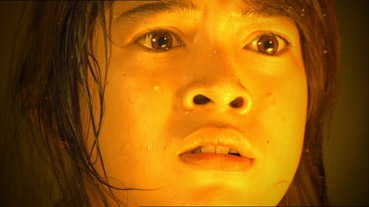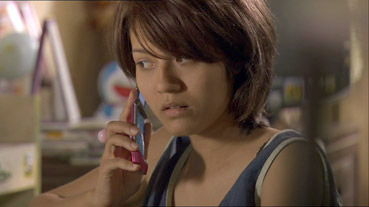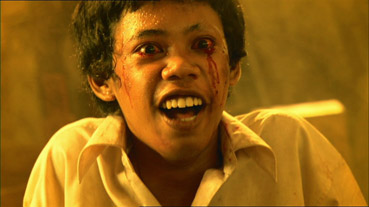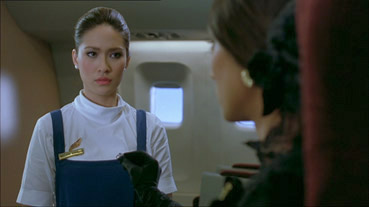|
Despite its inability to deliver the sort of plot complexity, character depth and even sustained tension of a feature-length narrative, the horror anthology movie just won't go away. Back in 2004, Three... Extremes [Sam gang yi] saw three of Asian cinema's most talented filmmakers – China's Fruit Chan, Japan's Miike Takashi and Korea's Park Chan-wook – explore the short film format to arresting effect. Now we have Phobia [See prang] (also titled 4bia in some western markets), which allows four hotshot Thai filmmakers the chance to ply their trade in similar fashion.

As is often the way with such films, especially those in which the stories are handled by different writers and directors, the results are variable, though all four here have their specific merits and standout aspects. Inevitably there'll be disagreement on which one is the best, and for a number of reasons my money's on the first. It's always a bit of a bummer when the subsequent stories don't match up to the opener, but there are no duds here and collectively they make for an engaging and intermittently inventive two hours. They also boast a couple of genuinely good scares, plus a few you'll see coming a mile away but will still be prompted to jump to anyway. The post-death experience figures in all four tales, but there are otherwise no links between them and the start of each is signified by only by a switch of locale, characters and visual style, eventually followed by a story title.
As a whole, this is a lively collection whose stories are varied enough in their content and handling to allow most genre fans to find at least one they will like. As is often the case with portmanteau horrors, the individual stories are neither narratively challenging nor particularly original, but collectively they have enough energy to suggest a rather promising future for this particular quartet of filmmakers and for Thai horror cinema in general.
1. HAPPINESS
The first story is written and directed by Yongyoot Thongkongtoon, whose previous films include Iron Ladies [Satree lek] (2000), the true story of a successful Thai volleyball team comprised entirely of gays, transvestites and transsexuals. It's gone straight on my viewing list. Happiness centres around Pin, a young girl confined to her high-rise apartment following a near fatal accident that left her with her leg in plaster. She's bored and lonely, so when she gets a text message from an unknown caller she cautiously responds and a virtual friendship begins. When the two agree to exchange photos via MMS, however, her new friend simply returns the one that she has just taken and sent to him. When she queries his actions he assures her that he's in the photograph, sitting right next to her...

In an age when the need to disable the mobile phone signal has ensured that almost every horror movie has a built-in cliché, any story constructed around a working mobile and its owner is off to a serious head start. It gets better. Text messaging is not only central to the story here, it's the only method of communication used – there's not a word of audible dialogue in the whole piece, and even a news story that helps clue Pin in to what may be happening is silently retrieved from the web.
Happiness is very much a tale of our time, not just in Pim's use of mobile phone and computer technology but her reliance on it. The only visitor she has is her landlady, who bangs noisily and repeatedly on the door for back rent, and her only communication with friends is through the text messages she sends and receives through her phone. Her isolation is a modern urban one, where virtual relations stand in for physical contact and where you don't have to live far from people to feel alone, something nicely captured by the balcony of Pin's apartment, where she stands in complete solitude as the city bustles and hums beneath her.
But this is no academic exercise in modern urban alienation but an engrossingly told story that builds to a climactic scene of genuinely breathless tension and the best jolt in the film, then provides the connecting dots for elements that until then could easily be seen as random, giving the whole story a very nice sense of completion.
2. TIT FOT TAT
An air of Final Destination and I Know What You Did Last Summer hangs over the second story, written and directed by Paween Purikitpanya, who made quite an impact with his 2007 debut feature Body sob 19. Here a group of no-good schoolkids kidnap their socially disadvantaged and nervous classmate Ngid, whom they blame for getting them expelled. An attempt to scare him by dangling him over the back of their fast-moving truck goes wrong and he falls into the road and is injured. A few days later he presents himself to them carrying an ancient book, one that when opened causes the reader to instantly suffer a violent death.

As you might imagine, mystery and uncertainty doesn't play a big part in this one, with surprises largely limited to the when and how of who gets it next. A rather neat twist has Ngid himself inadvertently catch sight of the book's deadly interior, which triggers his his own death and requires him to complete his revenge as a twitchy ghoul. Although bristling with energy, the episode is infuriatingly directed in the manner of a hyper-kinetic music video, rendering the characters as objects to be jump-cut, freeze-framed and heavily tinted, with everything photographed either at offbeat angles or as if camera and subject have been caught in an earthquake. The frenetic editing adds to the sometimes dizzying incomprehension, and there's a lot of CG in this one. A shame, because there's some very good stuff nestled in there, particularly the genuinely creepy image of Ngid and his ghoulish companions going about their unearthly business.
3. IN THE MIDDLE
It's almost a tradition with anthology films that the jocular episode gets penultimate position to theoretically give the final story more impact. This one was written and co-directed by Banjong Pisanthanakun, half of the team responsible for the derivative but seriously creepy Shutter (2004), one of several films that are a little too overtly referenced here. Indeed, that's a film I'd advise seeing before you watch this one if you don't want the ending of that film spoilt (and believe me, you don't).
Four boys on a jungle camping trip wonder one night how their companions would react if one of them were killed. One of their number, Aey, jovially suggests that if he died he'd come back and haunt his friends, starting with whoever is sleeping in the middle of the tent. The very next day their dinghy overturns and Aey is lost rescuing one of his friends. That night, no-one wants to lie in that middle position, so all are greatly relieved when Aey turns up safe and well. But is he really?

One of those stories where the solution to the mystery is so obvious that it's probably not the real solution at all. The four young actors are engaging enough, and although the film referencing gets a bit much, compensation is provided by some genuine wit, with one of the group wondering why ghosts are always females with white faces with long dark hair,* and another suggesting that the end of Shutter was actually inspired by a key moment in Titanic.** You may well have guessed what's actually going on by the time the story is ready to tell you (I certainly had), and it raises a couple of internal logic questions that I can't discuss without revealing the twist, but the journey there is fun and does boast a couple of reasonable scares.
4. LAST FRIGHT
The final story was written and directed by Parkpoom Wongpoom, the other half of that Shutter team. Attractive young air hostess Pim is recalled to work for a special charter flight, a repeat of one taken by a foreign prince and his new wife the previous year that the princess is taking alone this time. She has requested the exact same crew as before, but circumstances result in Pim having to tend to the princess by herself. It turns out that Pim was serving the prince in more ways than one, a fact that the princess is clearly aware of, and as her anger mounts, her increasing hostility leads to an accident that results in her death. Preparations are made to fly her body home, a journey Pim is also ordered to take as the airline's representative, but when the flight hits bad weather, the body is dislodged and Pim starts to suspect that the woman she has wronged has come back to haunt her.
Although it could well be a deliberate play on the western (mis-) conception of eastern pronunciation of English words (all conversations between Pim and the princess are conducted in English), the title Last Fright also has an EC horror comic or Twilight Zone ring, which is exactly how the episode plays out. A morality tale whose protagonist is isolated with a restless corpse in a raging thunderstorm, this plays like a homage to the golden days of Amicus and could almost have been a lost segment of Twilight Zone: The Movie. It's scares are old-fashioned and it's never as genuinely unsettling as Happiness, but it's still an enjoyable ride and provides a suitably full-blooded final act.
A very nice 1.78:1 anamorphic transfer with an impressive level of detail and solid but not over-aggressive contrast. Daytime exteriors tend to come off best, though the picture loses little of its integrity in the darker scenes, of which there are many. The use of colour varies from story to story but is reproduced without any obvious issues, from the vivid tinting of Tit for Tat to the more naturalistic daytime hues of In the Middle both coming over well.

The original Thai soundtrack is available in that old Tartan trio Dolby stereo 2.0, Dolby 5.1 surround and DTS 5.1 surround, with the surround tracks coming off best and for the most part sounding virtually identical to each other. Clarity and tonal range are of the expected standard for a modern horror film, with some dizzying use of the surrounds in a multiple death scene in Tit for Tat, while for thumping LFE bass you'll do no better than the airplane take-off and thunderstorm in Last Fright, which also makes great use of the surrounds.
Cast and Crew Interviews (12:13)
A pre-release promo in which the directors and stars of the four stories outline the plots and enthusiastically assure us that this is not like any horror movie you've ever seen. Some very brief behind the scenes snippets and a few extracts from the film are included, and the interviews are cut with a speed that allows almost no pause for breath.
Theatrical Trailer (2:56)
An decent sell comprised of compressed versions of all four stories, complete with spoilers, so definitely don't watch this just before the feature.
As is so often the way with portmanteau horror films, the individual episodes here lack the depth of story and character of their feature-length equivalent, particularly Tit for Tat, where both have to do battle with an unbroken barrage of audio-visual tics. All four stories have their specific pleasures, but it's Happiness that I found the most satisfying, being the most adventurous, inventive and structurally solid, as well as the most authentically tense. The whole film looks and sounds fine on Icon's DVD, and should certainly be on every discerning horror fan's viewing list.
* Just in case you were wondering, it's because this is a traditional Eastern image of what a ghost looks like, the equivalent our white, sheet-clad spooks. Only scarier.
** It wasn't, of course. For those who've seen Shutter, that film's creepy conclusion is drawn from Eastern folklore – a Japanese friend I watched the film with guessed the end before it was revealed precisely because it was based on stories she read at a young age.
|